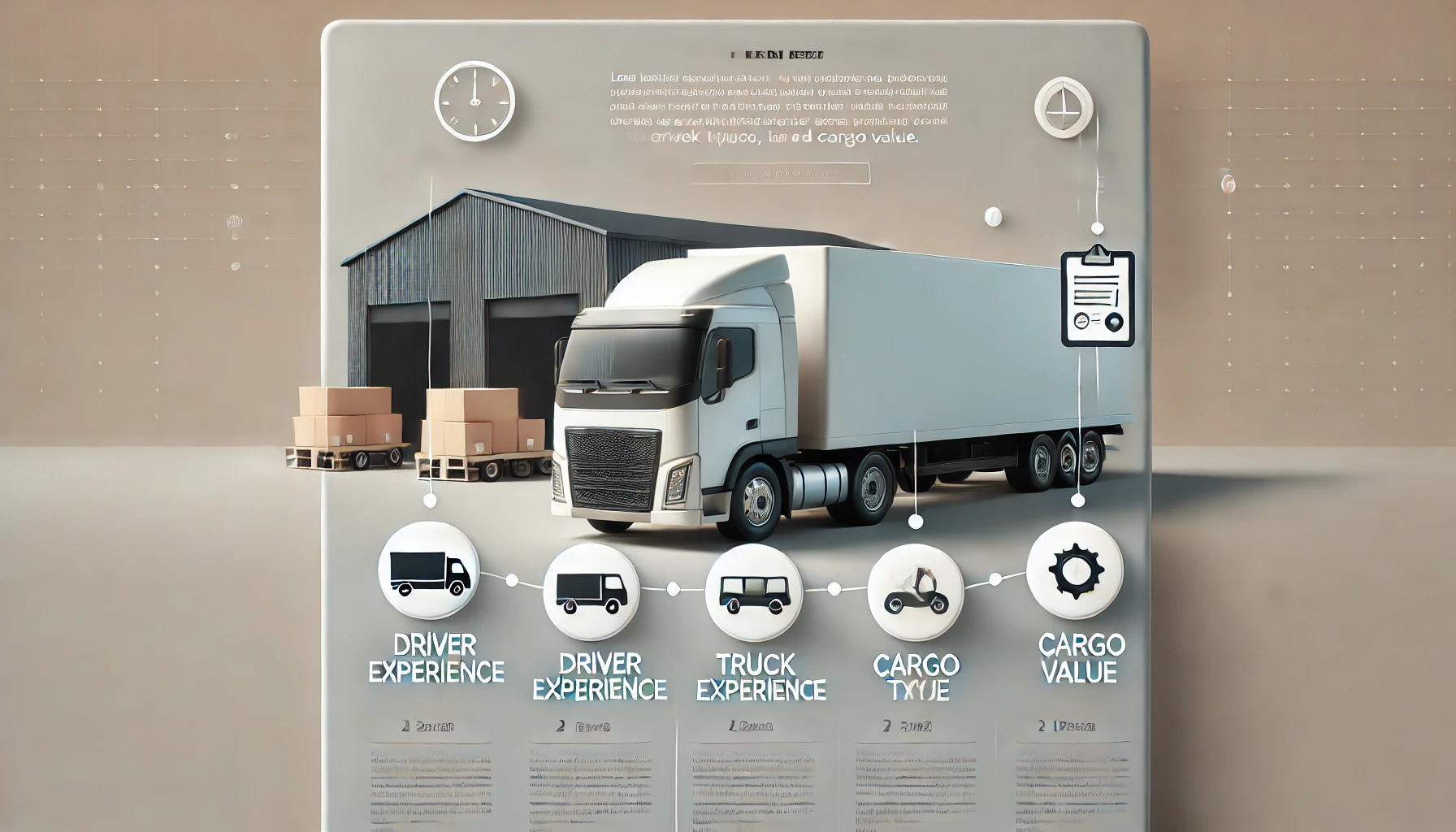As we move into 2024, understanding the key elements that influence box truck insurance costs is essential for businesses aiming to optimize their expenses. Box truck insurance is a critical financial consideration, especially for companies heavily reliant on transportation. Numerous factors, from the type of cargo to driver experience, can impact the final box truck insurance costs, making it vital for business owners to comprehend these variables for effective budgeting and decision-making.

1. Vehicle Type and Specifications
The type and specifications of a box truck significantly impact insurance costs. Newer and larger trucks typically attract higher premiums due to increased repair costs and the potential for greater damage in the event of an accident. Factors such as the gross vehicle weight rating (GVWR), model year, and additional safety features like anti-theft devices play a crucial role in determining rates. Understanding these specifications can help businesses select the most cost-effective vehicles and ensure they are fully insured against risks on the road.
Insurance providers often assess the size and model of a box truck, as these characteristics determine the risks associated with operating the vehicle. For instance, heavier trucks may be more susceptible to damages, impacting premiums. By investing in trucks with modern safety features, business owners can potentially reduce insurance costs as providers may offer lower rates for vehicles equipped with advanced safety measures. Making wise choices in fleet management and vehicle maintenance can optimize costs over time.
2. Cargo Type and Value
The nature of the cargo transported can either increase or decrease box truck insurance costs. For instance, high-value items, electronics, or temperature-sensitive goods often lead to higher premiums due to increased risk. On the other hand, general commodities or bulk items may attract lower rates. Insurance providers carefully assess the potential for theft, damage, and specific coverage needs, making it essential for businesses to evaluate their cargo types when estimating insurance expenses for the year ahead.
Businesses that transport fragile or perishable items should consider additional coverage, as standard liability insurance may not fully cover damage risks for these products. Companies specializing in logistics can benefit from customizable policies that provide adequate cargo protection without overspending on premiums. Evaluating cargo insurance options and selecting tailored packages can optimize both costs and protection.

3. Driver Experience and Safety Record
Drivers’ experience levels and safety records remain one of the most influential factors in calculating box truck insurance costs. Insurance providers prefer experienced drivers with clean records, typically aged between 30 and 50, as they pose fewer risks. Businesses can reduce premiums by implementing strict hiring standards, including background checks and regular training programs. Additionally, monitoring driving habits and enforcing safety protocols contribute to a better safety record and can positively impact insurance costs.
Companies can save on premiums by prioritizing driver safety. Regular safety training and incentivizing good driving behavior can lead to notable reductions in insurance expenses. For example, insurers might offer discounts if companies implement GPS tracking, enabling real-time driver monitoring. Data from these devices helps identify and address risky driving behaviors, promoting a safety-focused culture within the organization.
4. Geographic Location and Operating Radius
The geographic location and the distances covered by box trucks also affect insurance rates. Operating within a high-traffic area or long-haul routes generally leads to higher premiums due to increased risk. Urban areas with dense traffic or regions with high accident rates can raise costs, as can extended routes across state lines. By understanding the implications of location on insurance, businesses can consider strategic adjustments in operations to optimize coverage expenses.
Insurance providers may also adjust premiums based on local conditions, such as weather patterns. For example, areas prone to heavy snowfall or hurricanes can increase the likelihood of accidents, leading to higher insurance rates. Optimizing delivery routes and avoiding high-risk zones when possible can potentially reduce premiums, as can securing regional-specific coverage tailored to local risk factors.
5. Coverage Options and Deductibles
The choice of coverage levels and deductibles impacts the overall cost of box truck insurance. Comprehensive coverage, liability limits, and specific protections like cargo insurance add to premium costs but provide extensive protection. Higher deductibles typically reduce monthly premiums, although they lead to greater out-of-pocket costs in case of a claim. Finding a balance between adequate coverage and manageable deductibles can help businesses maintain affordable insurance without sacrificing necessary protections.
Business owners must regularly review their policies to ensure their coverage aligns with operational needs. For example, companies with robust financial resources might opt for higher deductibles to lower monthly premiums. In contrast, businesses with limited cash flow may benefit from higher premiums but lower deductibles to manage unexpected repair costs.
Tips for Reducing Box Truck Insurance Premiums
Business owners can reduce their box truck insurance costs by a lot when they plan strategically and manage proactively. They can achieve substantial savings while keeping complete coverage through several proven methods.
Implementing Safety Programs
Resilient safety programs lead to most important premium reductions. Companies receive substantial discounts when they show their steadfast dedication to safety through detailed driver training programs. These safety initiatives work best:
- Regular defensive driving courses
- Performance monitoring systems
- Safety incentive programs for drivers
- Ongoing regulatory compliance training
Bundling Policies
A single provider can offer notable advantages when you combine multiple insurance policies. Insurance companies reward customers with discounts that average 15% for basic policy bundling, and savings can reach 20-30% when combining multiple commercial policies. This strategy reduces costs and makes policy management easier to handle.
Choosing Higher Deductibles
Higher deductibles can lower your monthly premium costs significantly, and this strategy needs smart financial planning. Companies that maintain stable cash flow and adequate reserves can take advantage of this approach. The benefits are clear since higher deductibles lead to premium reductions of 15-30%. Companies must make sure they can handle the increased out-of-pocket expenses when claims arise.
Regular Policy Reviews and Comparisons
Regular policy reviews can help you find ways to save money and keep your coverage aligned with your business needs. Insurance experts suggest reviewing your policies every quarter to:
- Check if your coverage meets current needs
- Take off coverage for vehicles you no longer use
- Update limits when your business changes
- Get quotes from different providers
Conclusion
Understanding these top factors affecting box truck insurance costs in 2024 can help businesses make informed decisions and budget more effectively. By analyzing aspects like vehicle specifications, cargo type, and driver records, companies can work proactively to optimize their insurance coverage. Strategically managing these factors allows for a balanced approach, ensuring essential protection while maintaining financial stability in a competitive market.
FAQs
How much does it cost to insure a 26-foot box truck in 2024?
In 2024, insurance costs for a 26-foot box truck typically range from USD 250 to USD 950 monthly, depending on factors like the truck’s use, location, and driver history.
Which factor has the most impact on box truck insurance rates?
Driver experience and safety record have a substantial effect, as insurance providers view drivers with clean records and extensive experience as lower risk, leading to lower premiums.
Does increasing deductibles reduce box truck insurance costs significantly?
Yes, higher deductibles can lower premiums by up to 15-30%. However, businesses should ensure they have sufficient cash flow to cover these deductibles if claims arise. For more details, visit Insurance Journal.
